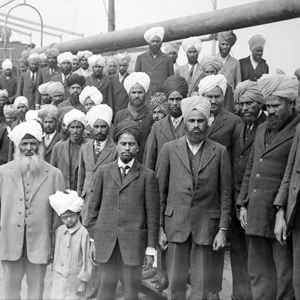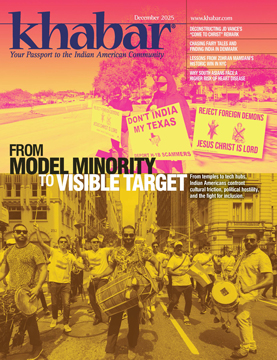Point of View: The American Dream Has Never Been Easy for Indians

Photo: Wikimedia Commons
While Trump 2.0 has barred many people of color who had already been approved for asylum, white Afrikaners have been let in as refugees for the first time. The “browning of America” has long been seen as a threat, even when the nation’s nonwhite population was small. We have made progress, but the anxiety remains, as do challenges—and the current period is a stark reminder of that dichotomy.
The 2020s in the U.S. bear little resemblance to the 1920s. The Harding-Coolidge era, commonly known as the Jazz Age or the Roaring Twenties, was marked by deep racism, reminding one of the Ku Klux Klan, eugenics, and a highly restrictive immigration bill. The Rising Tide of Color, which warned about “the threat against white world-supremacy,” was so influential that the book’s author, Lothrop Stoddard, even gets a mention in The Great Gatsby, F. Scott Fitzgerald’s famous novel from 1925. After misnaming the book, Tom, a character in the novel, says, “Well, it’s a fine book, and everybody ought to read it.” His white supremacist views were widely shared back then.
The U.S., thankfully, has come a long way over the last century. It is nevertheless striking how the past hostility towards immigration, especially immigration from the “wrong” countries, has found echoes in the present. And it’s happening not just in America.
Western democracies have been so unsettled that British Prime Minister Keir Starmer recently vowed to end the “failed experiment in open borders,” even though his nation saw a 50 percent drop in net migration last year. “Every area of the immigration system—work, family, and study—will be tightened up so we have more control,” he declared. That sums up what’s already happening in the U.S., which is led by a party that’s aligned with the Conservatives rather than Starmer’s Labour Party. These days, populism appeals to both sides of the Left-Right divide.
Indian students in the U.S. today find themselves in a transformed country. They form the largest cohort of international students, and many are having second thoughts about their decision to come to America. The same could be said about other Indians on non-immigrant visas. Would these students have taken out loans, and spent so much money, if they’d known what was at stake? In the run-up to the 2024 election, an intense focus on undocumented migrants deflected attention from what Trump and MAGA really wanted: a drastic reduction in overall immigration. That explains why they’re cracking down on “foreigners” and asking people to “self-deport”—an ugly nonword that doesn’t make sense because it’s contradictory. You can’t deport yourself.
Using flimsy reasons to cancel visas, deporting people without due process, and aggressively questioning the legitimacy of green cards, might seem like bait-and-switch to those who entered the U.S. before this year. Did they make a mistake? The Trump administration may end OPT (Optional Practical Training) for international students, and there are bound to be other changes. The recent decision to temporarily halt student visa appointments shouldn’t have come as a surprise.
Indians have a lot to lose, and not just students. The largest group of H1-B workers is also from India; then there are all those undocumented migrants living fearfully in the shadows.
For the first time, in a remarkable development, white Afrikaners have been let into the U.S. as refugees. Their claim of discrimination in formerly segregated South Africa, which has a law-and-order problem, was dubious at best. Trump’s conspicuous welcome mat for them was telling, given that he’d already suspended the refugee resettlement program, which has affected tens of thousands of approved refugees, including Afghans who had risked their lives to help American soldiers. Also, about half a million migrants from four countries have lost their temporary legal status in the U.S., and 19 nations have been affected by travel restrictions. Three dozen more countries may be added to this list.
Some immigrants, as long as they’re the right kind, are still welcome. This is not new. India was a part of the Asiatic Barred Zone for 35 years. That ended in 1952, but the national origins quota system, which shut out Asians and other nonwhites, wasn’t abolished until 1965. It was the culmination of a long battle that actually began in the late 19th century. Chinese immigrants became the first group to be barred from America because of their race. Following an arduous battle, they won the right for equal protection under the law regardless of race, and it was also because of a Chinese worker that immigrants won the right to citizenship for children born in the U.S. That privilege could be overturned if Trump 2.0 has its way.
Until the early years of the 20th century, Indian immigrants didn’t attract much attention. But when they did, the reception was hostile. In 1911, the year of the Delhi Durbar, the U.S. Immigration Commission called Indians “the least desirable race of immigrants admitted thus far.” In a well-publicized case, Bhagat Singh Thind, who fought for the U.S. in World War I, couldn’t become an American. Not once, but twice, and he was denaturalized both times.
On the second occasion, when Thind’s citizenship was revoked because he wasn’t seen as “white,” he became a test case. Consequently, according to one estimate, more than 70 naturalized Indians were stripped of their U.S. citizenship between 1923 and 1926, making them the first immigrant group to be uniformly denaturalized. The impact was devastating. Ownership of property was tied to U.S. citizenship, which meant that Indians lost their land, businesses, and livelihood. In one tragic case, Vaishno Das Bagai died by suicide after losing his house and store, leaving behind a widow and three young children. Thind, who married an American woman, had a happier ending, although his battle wasn’t easy. He became a U.S. citizen in 1935.
For nonwhites, it took another thirty years for the barriers to fall. The Immigration and Nationality Act of 1965 truly changed America. While we should be grateful for the anti-discriminatory legislation of the mid-1960s (which includes the Civil Rights Act of 1964), it’s worth remembering that those who supported the immigration bill didn’t anticipate the sweeping changes. They couldn’t have, of course, because the nation then was very different.
Representative Emanuel Celler, a co-sponsor of the 1965 bill (also called the Hart-Celler Act), argued that the number of Asian and African immigrants wouldn’t be high, because not enough of them would be able to compete and qualify for entry. He added, “Since the people of Africa and Asia have very few relatives here, comparatively few could immigrate from those countries because they have no family ties in the U.S.”
He couldn’t have been more mistaken. For over two decades now, Asian Americans have been the fastest-growing racial or ethnic group. The 1965 bill’s Family Reunification category, which was supposed to favor Europeans, has benefitted Asians more than any other group. The “ethnic mix,” which Senator Edward Kennedy claimed wouldn’t “be upset,” did change.
So, to fully understand Trump 2.0’s policies, we should also consider the impact of this immigration bill, whose 60th anniversary we mark this year. For MAGA, what’s unfolding now is a legitimate culture war against a “liberal” establishment that has foisted upon them a country they don’t recognize, making them feel like “strangers in their own land,” as the title of a book puts it. There’s a lot else going on, for sure, but demographic change remains a key factor.
Indian Americans have thrived as a community. We can’t deny it, and the U.S. gets credit for making that success possible. However, we shouldn’t forget another fact that’s also undeniable. For nonwhites like Indians, who also happen to be from a region that’s not predominantly Christian, the path to the American Dream has long been steep. The problems will continue, even as there is progress—and the current period is a stark reminder of that duality.
For Chinese observers, 2025 came not as a surprise but as a shocking reminder. Within a few weeks of Trump’s inauguration, as a blizzard of executive orders unleashed chaos and confusion, and the Elon Musk-led DOGE (Department of Government Efficiency) began a full-scale assault on the civil service—sometimes gleefully, often callously—the Chinese wondered if a Cultural Revolution was underway in America. They were right. DOGE had little to do with improving efficiency, and a lot to do with waging a war on “liberal” America. Not only were the savings vastly exaggerated, but Trump’s so-called One Big Beautiful Bill has been dubbed a Debt Bomb.
The relentless attacks on academia and other liberal institutions are unlikely to stop anytime soon. Despite big differences, they’re indeed reminiscent of Mao’s brutal, decade-long Cultural Revolution (1966-1976), which devasted China and traumatized the Chinese for years. One only has to remember some past statements attributed to budget director Russell Vought (“We want to put them in trauma”), JD Vance (“The professors are the enemy”), and Donald Trump (The press is “truly the enemy of the people”). These chilling remarks could be straight out of Chairman Mao’s playbook.
In 2015, when America marked the 50th anniversary of the Immigration and Nationality Act, Obama, the nation’s first nonwhite president, was still in office, and the White House hosted a special swearing-in ceremony for newly naturalized citizens. Ominously, that was the year Trump decided to enter the 2016 presidential race, which he ended up winning.
Trump’s point about accepting white Afrikaners as refugees, after rescinding the program for refugees who had already been approved, is not that he and officials like Stephen Miller think it will make a difference demographically. It won’t, even if the entire Afrikaner population is let in. Trump’s gesture was symbolic, and his MAGA supporters know that. They like him because he understands their anxieties and concerns. It’s the same with the anti-DEI (Diversity, Equity, and Inclusion) crusade. That fight may be more serious, but the symbolism is just as important. The MAGA movement has a vision of the nation that Trump 2.0 is trying to uphold.
How will this Cultural Revolution in the U.S. end? It’s hard to predict at this time. But what’s clear is that the window for this revolution is narrower, and the resistance they face won’t disappear.
I turn again to The Great Gatsby for a well-known quote. Towards the end of the novel, the narrator says, “They were careless people, Tom and Daisy—they smashed up things and creatures and then retreated back into their money or their vast carelessness, or whatever it was that kept them together, and let other people clean up the mess they had made . . .”
Murali Kamma is the managing editor of Khabar. A slightly different version of this article appeared in The Quint, a news and opinion media outlet based in New Delhi, India. Please send your comments to letters@khabar.com
Enjoyed reading Khabar magazine? Subscribe to Khabar and get a full digital copy of this Indian-American community magazine.
blog comments powered by Disqus










